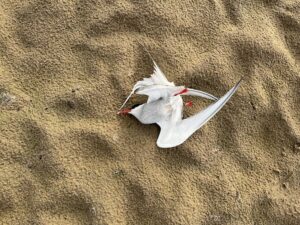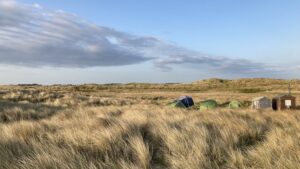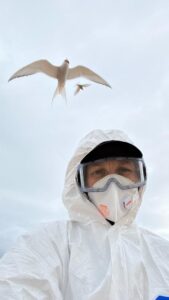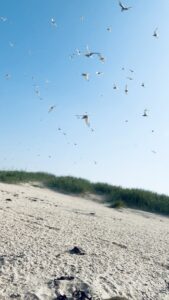As the worldwide spread of avian influenza continues, Amy Liptrot finds havoc and hope at Long Nanny Shorebird Breeding Site — the largest arctic tern colony on mainland Britain.
All photos: Kate Phillips.

A flock of thousands of arctic terns rising — light bright seabirds, all sharp angles and perfect curves, tipped with red and black, screeching of the sea — was a spectacle I thought I might never witness again. So visiting Long Nanny Shorebird Breeding Site on the Northumbrian coast in early June, I was elated to see the largest arctic tern colony on mainland Britain. National Trust coastal rangers, including my friend Kate Phillips, had counted over 1600 breeding pairs, chicks were beginning to hatch, and they were feeling positive about the coming season.
By the time I returned a few weeks later in July, the colony had been hit terribly by avian influenza, with over 1000 birds dead.
Arctic terns are famous for undertaking the longest migration of any animal, travelling all the way to Antarctica and back to northern Europe each year. They are a special but threatened bird: numbers in Orkney, where I’m from, have declined by around 75% from 33,000 pairs in 1980 and the colony that was on the farm where I grew up is now completely gone.
The rangers of Long Nanny have taken on an immersive seasonal job, living in tents in the sand dunes for the summer and working shifts around the clock, alongside volunteers. They are what ranger Grace McFarlane calls “bird protection warriors”, deterring predators including foxes, birds of prey, stoats and badgers; welcoming visitors and asking people to keep their dogs on leads; building fences and even being ready to raise nests at particularly high tides.

The terns nest in ‘scapes’ among the sand dunes and marram grass, the beach stretching out below. The site also has rare nesting little terns — 2% of the UK’s population — and ringed plovers. It’s a rich ecosystem with many wild flowers and other bird species: I saw a barn owl, a whimbrel and a pair of linnets.
I spoke to Kate about how the season progressed. The terns started arriving at the end of April, building up to around 3000 birds: “There were so many birds and so many nests and it felt really vibrant and exciting.” The rangers and volunteers noticed some black-headed gulls getting sick on a spit of land close to the colony. They saw a few dead terns but within a normal amount. For a few days they noticed that the terns were behaving erratically: flushing and making more distress calls than normal. “Then I’d found one that looked like it literally dropped out in the sky,” says Kate, “I wrote in the shift notes, ‘It’s really odd. This bird looks like it died in flight’… When you find them dead after bird flu, usually their wings are open. And the necks look broken. It’s like they’ve collapsed on themselves.”
In June, there were more than two weeks with no rain and high temperatures. A ranger checking the colony found 12 dead chicks, which they initially thought was due to stoat predation or heat exhaustion. “And then we went down together and over the course of half an hour picked up 54 dead chicks,” Kate says. The 54 dead chicks indicated something was seriously wrong and were immediately removed. In the next days, death numbers increased and testing confirmed avian flu was in the colony.
In the following days, the rangers, in full PPE including white suits and protective eyewear, collected hundreds of dead arctic tern chicks each day. “You go out to go and collect them with your litter picker and your bin bags. And it is quite brutal and horrible. I’ve seen the distress of adult birds who were going out fishing, coming back with fish and then all their chicks are just… dead on top of each other.” Kate is upset, recalling finding living birds underneath dead ones. In total, they recorded deaths of 1066 arctic tern chicks and 237 adults, as well as 19 little tern chicks and 10 adults.

The current outbreaks of Highly Pathogenic Avian Influenza (HPAI) have been causing devastation in many wild and domestic bird species worldwide since 2020, particularly affecting seabirds. It is not known how HPAI entered Long Nanny, but it is likely it was spread by an infected gull. There are other theories however, and Kate says: “A few days before it happened, we had a dead seal wash up on the beach. Seals have been known to get it because they roll around in lots of bird poo on the rocks. The idea of them transmitting it back to birds has never been something that’s been really talked about. However, a lot of the fledglings were around the seal.”
When I returned in July, the site was dramatically quieter, partly because of the losses but also because the terns had already left for their migration. “It’s been really accelerated this year”, says Kate, “In previous years it’d be another two weeks before [they leave]. But this season’s been so odd with the weather and the flowers and everything has been go, go, go… It feels pretty autumnal now.”
This is just one colony — although an important one — but it is a closely observed representation of what is happening to birds around our coasts. At a time when seabirds are threatened by so much — rising ocean temperatures, overfishing, habitat loss — the addition of avian flu seems especially cruel. Kate tells me that her colleagues on the Farne Islands are losing hundreds of birds every day including puffins, kittiwakes and guillemots.
Also cruel is the impact on the rangers whose job is to protect the birds but were helpless against the disease. Kate talks about the support of the group allowing them to cope. She shows me a photo of her in her PPE with a rainbow umbrella fixed to her head: “because collecting dead birds is so traumatic, the girls on the Farnes were concerned about me and thought I needed cheering up. So they gave me one of these… That was to protect my head”. The terns will divebomb to protect their nests.

We walked on the beach where the last 95 or so arctic terns and little terns gathered on the sand, waiting for the right moment to fly. To be among these survivors at a moment before they leave for the most epic of migrations felt charged with emotion. It is thanks to the rangers that a good number have made it to this point. “It’s made me feel just how important it is that we can help influence nature’s success and recovery.” says Kate. I want the wild birds to leave quickly and safely and think of this by Orkney poet Yvonne Gray:
VOYAGERS
Day is fading. Like tapers or thorns
a garland of origami birds dangles
from a rafter in Burnmouth Bothy.
From Noup Head to Whitestane Moss
blades of light, primeval cries dissolve
into air. The sky falls silent. Arctic terns flicker
over the Atlantic, the Weddell Sea –
trace ancient tracks between earth and stars,
tiny cartographers ever mapping
the invisible or transient – shifting tides;
twisting currents of air; the swift passage
that spans the ocean, contracting time.
Lighted continents pass them by,
freighted ships sailing into the night.